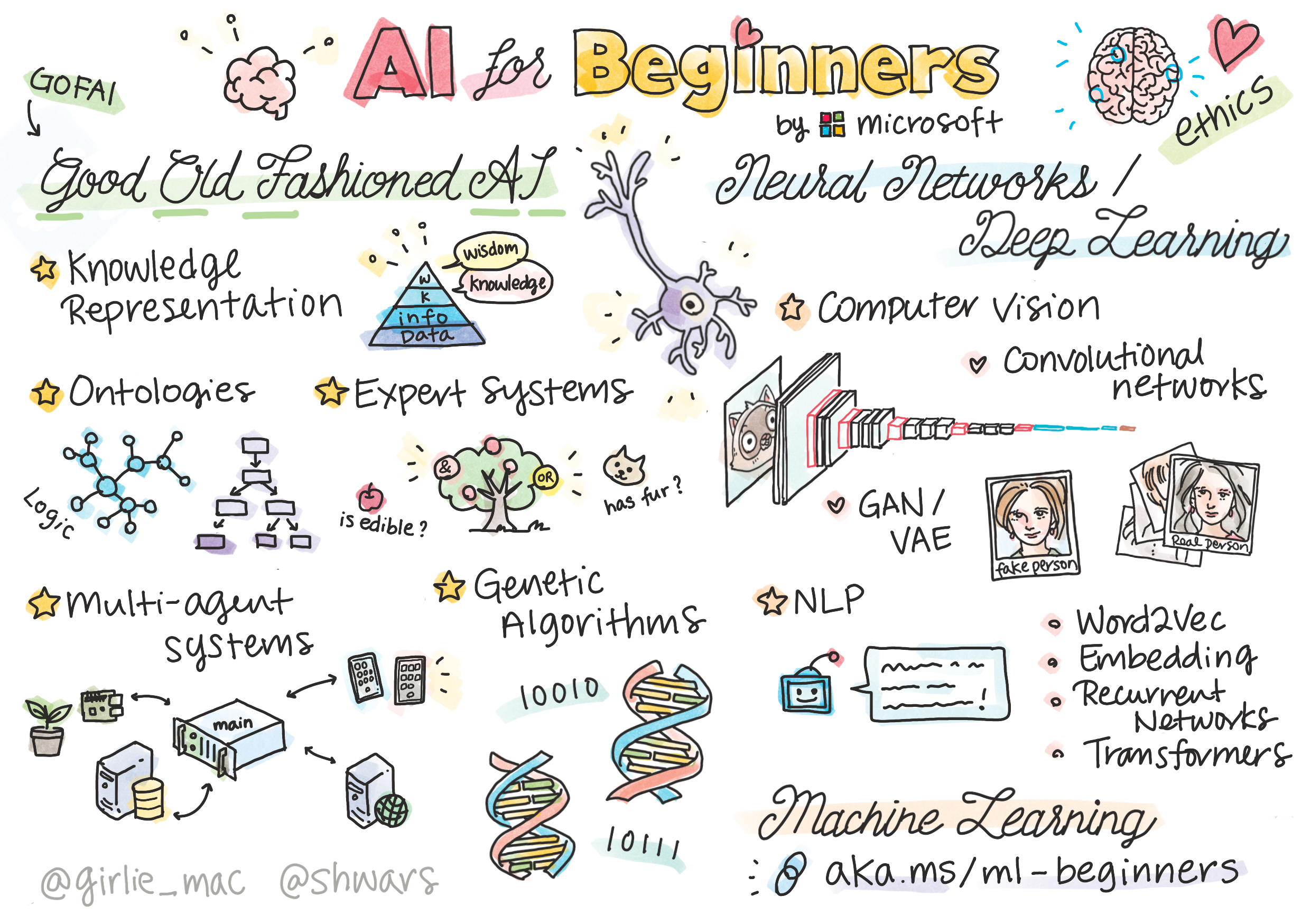|
|
||
|---|---|---|
| .devcontainer | ||
| .github/workflows | ||
| binder | ||
| etc | ||
| images | ||
| lessons | ||
| translations | ||
| .gitignore | ||
| .nojekyll | ||
| LICENSE | ||
| README.md | ||
| SECURITY.md | ||
| index.html | ||
README.md
Artificial Intelligence for Beginners - A Curriculum
 |
|---|
| AI For Beginners - Sketchnote by @girlie_mac |
Explore the world of Artificial Intelligence (AI) with our 12-week, 24-lesson curriculum! It includes practical lessons, quizzes, and labs. The curriculum is beginner-friendly and covers tools like TensorFlow and PyTorch, as well as ethics in AI
What you will learn
In this curriculum, you will learn:
- Different approaches to Artificial Intelligence, including the "good old" symbolic approach with Knowledge Representation and reasoning (GOFAI).
- Neural Networks and Deep Learning, which are at the core of modern AI. We will illustrate the concepts behind these important topics using code in two of the most popular frameworks - TensorFlow and PyTorch.
- Neural Architectures for working with images and text. We will cover recent models but may be a bit lacking in the state-of-the-art.
- Less popular AI approaches, such as Genetic Algorithms and Multi-Agent Systems.
What we will not cover in this curriculum:
Find all additional resources for this course in our Microsoft Learn collection
- Business cases of using AI in Business. Consider taking Introduction to AI for business users learning path on Microsoft Learn, or AI Business School, developed in cooperation with INSEAD.
- Classic Machine Learning, which is well described in our Machine Learning for Beginners Curriculum.
- Practical AI applications built using Cognitive Services. For this, we recommend that you start with modules Microsoft Learn for vision, natural language processing, Generative AI with Azure OpenAI Service and others.
- Specific ML Cloud Frameworks, such as Azure Machine Learning, Microsoft Fabric, or Azure Databricks. Consider using Build and operate machine learning solutions with Azure Machine Learning and Build and Operate Machine Learning Solutions with Azure Databricks learning paths.
- Conversational AI and Chat Bots. There is a separate Create conversational AI solutions learning path, and you can also refer to this blog post for more detail.
- Deep Mathematics behind deep learning. For this, we would recommend Deep Learning by Ian Goodfellow, Yoshua Bengio and Aaron Courville, which is also available online at https://www.deeplearningbook.org/.
For a gentle introduction to AI in the Cloud topics you may consider taking the Get started with artificial intelligence on Azure Learning Path.
Content
Each lesson contains
- Pre-reading material
- Executable Jupyter Notebooks, which are often specific to the framework (PyTorch or TensorFlow). The executable notebook also contains a lot of theoretical material, so to understand the topic you need to go through at least one version of the notebook (either PyTorch or TensorFlow).
- Labs available for some topics, which give you an opportunity to try applying the material you have learned to a specific problem.
- Some sections contain links to MS Learn modules that cover related topics.
Getting Started
- We have created a setup lesson to help you with setting up your development environment. - For Educators, we have created a curricula setup lesson for you too!
- How to Run the code in a VSCode or a Codepace
Don't forget to star (🌟) this repo to find it easier later.
Meet other Learners
Join our official AI Discord server to meet and network with other learners taking this course and get support.
Help Wanted
Do you have suggestions or found spelling or code errors? Raise an issue or create a pull request.
Special Thanks
- ✍️ Primary Author: Dmitry Soshnikov, PhD
- 🔥 Editor: Jen Looper, PhD
- 🎨 Sketchnote illustrator: Tomomi Imura
- ✅ Quiz Creator: Lateefah Bello, MLSA
- 🙏 Core Contributors: Evgenii Pishchik
Other Curricula
Our team produces other curricula! Check out:







